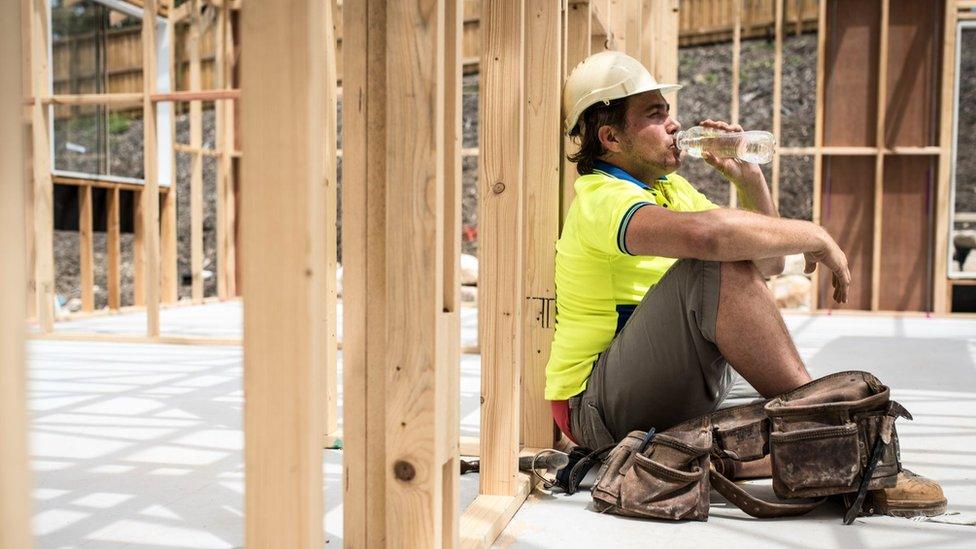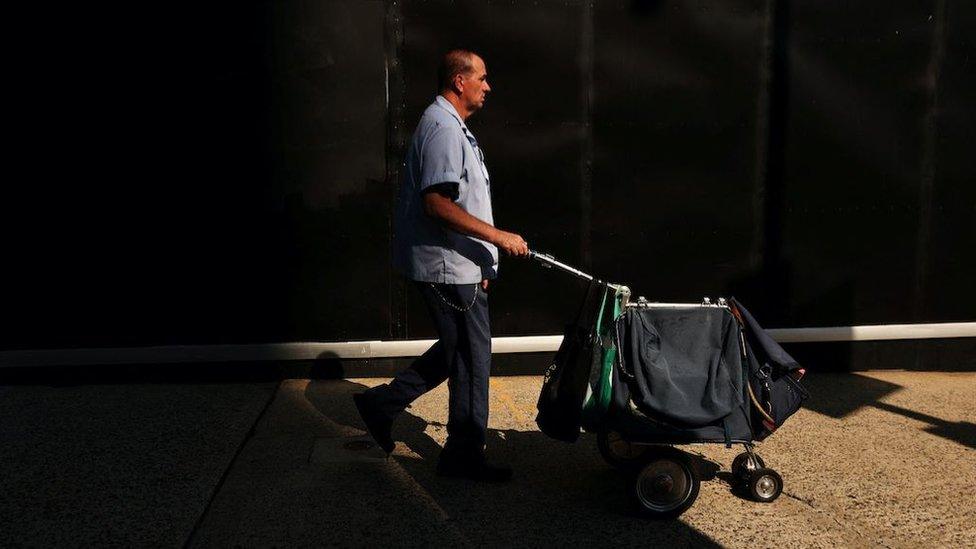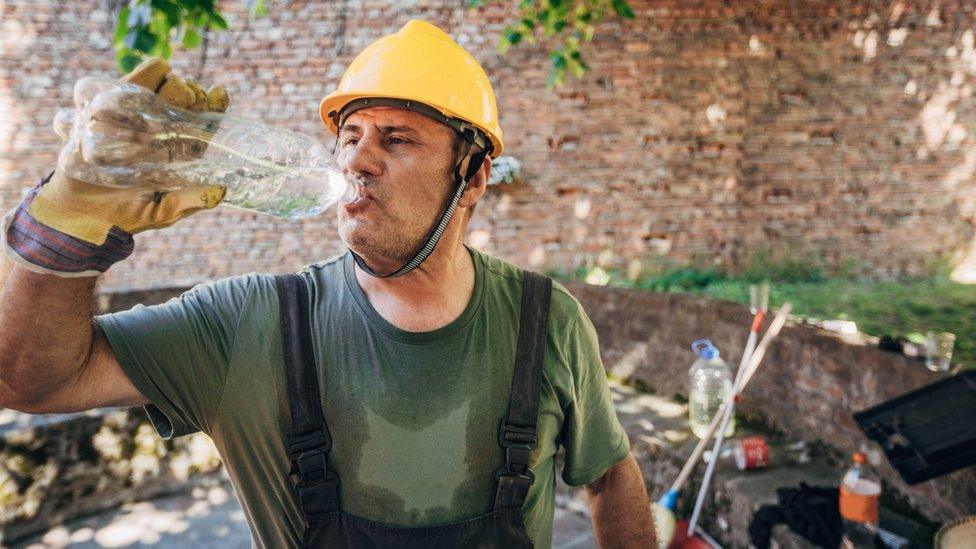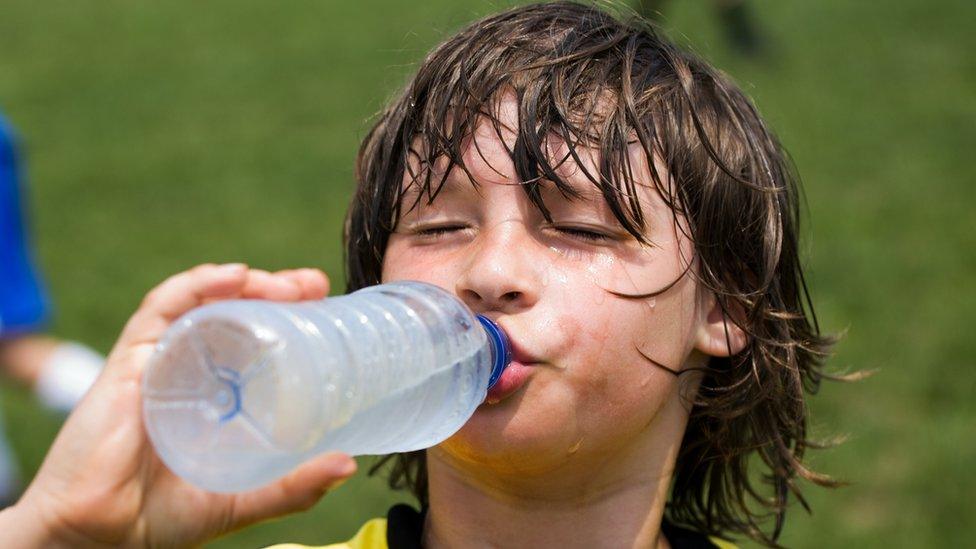Scorching heat fuels calls for worker protections
- Published

Millions of people in the US are under excessive heat warnings
Worker advocates in the US are renewing calls for protections from extreme temperatures, amid a heat wave that has claimed the lives of at least a dozen people.
Cities including Las Vegas and Phoenix are bracing for temperatures of up above 43C (110F) this weekend.
Calls for action intensified after a US postal service worker died in the punishing Texas heat last week.
Eugene Gates Jr, who had delivered mail for the US postal service for more than 35 years, collapsed in a customer's yard and was pronounced dead at the hospital.
The Occupational Health and Safety Administration is investigating the death, the cause of which has not been formally determined.
The incident has been received as another wake-up call, with Texas congresswoman Jasmine Crockett urging action to "prevent avoidable deaths such as this".
"I don't care what job that you have - no one should be out in that heat," Mr Gates's widow, Carla Gates, told CBS, the BBC's US news partner.
The US postal service declined to comment to the BBC about what adjustments it was making in places grappling with high temperatures. It said it provides all staff with training about heat-related illness.
Amazon, which faced its own questions after video of one of its delivery contractors apparently swooning in the Texas heat went viral this week, said it adjusts routes to account for heat once the heat index hits 90 degrees.
It said it had started adding up to two hours of additional breaks for drivers in Texas in mid-June as temperatures climbed.
As of Friday afternoon, routes originating out of more than 170 delivery stations across the country were operating with adjustments for various weather-related reasons.
"We're very thankful to report this delivery driver is OK and feeling well. There's nothing more important than the safety and health of our employees and delivery partners, especially during times of extreme temperatures, and we take a lot of precautions to minimize risk," Amazon spokeswoman Maureen Lynch Vogel said.
Workplace deaths due to heat have risen since the 1990s, according to the Department of Labor, external. It recently reported that 36 people died in work-related deaths due to heat exposure in 2021.
Juley Fulcher, worker health and safety advocate for progressive non-profit Public Citizen, said those figures dramatically understate the problem.

Extreme heat exposes workers to risks
Her organisation, which has petitioned the government to craft national heat rules for employers, estimates that heat exposure is responsible for as many as 2,000 worker fatalities in the US each year and as many as 170,000 injuries - many of them arising from indoor work in restaurants and warehouses, as well as outside jobs.
Heat waves, which typically mean workers get little respite from the heat overnight, intensify the risks, she said.
"It's a huge problem," she said. "Action is long overdue."
Ms Fulcher said national standards should require accommodations such as breaks and water starting at about 80F (26C) - with more adjustments as temperatures rise.
Those kinds of protections are already in place in some countries, such as Germany. The UK does not offer guidance on a maximum temperature at which it is safe to work, but some called for rules to be put in place amid last year's heat wave.
In the US, there are no national rules and just three states currently require employers of all kinds to provide adjustments in response to heat.
A handful of other states have started working on their own measures in recent years, according to Ms Fulcher.
But Texas recently loosened requirements, passing a state law that will nullify local requirements, including ones that would require 10-minute water breaks for construction workers every four hours.
Juan Pedro Munoz, a construction worker in Austin, said he was concerned about losing those protections. In the current conditions, he said he has been advising his team of four to take breaks and drink water every hour.

Juan Pedro Munoz
"It's hot - too hot," the 45-year-old told the BBC in Spanish. "We need time ... so that we don't have to go to the hospital."
While the risks of heat exposure in the workplace have been identified for decades, momentum to put in place protections has only started to gain traction more recently, as a rising number of heat waves and worker incidents raise pressure.
This month, UPS agreed to install air-conditioning in new delivery trucks, a key worker demand made in ongoing contract talks with the Teamsters Union.
Amazon has also invested to upgrade its fleet. It said all of its company-branded delivery vans had air-conditioning, which drivers were encouraged to run during their breaks in periods of extreme heat. Drivers also receive water and other drinks.
In 2021, the US Labor Department started crafting a national rule for employers, after rebuffing a 2011 petition to do so. The rule-making process typically takes years.
The agency also launched the country's first-ever "national emphasis" programme focused on the problem last year, warning that "heat illness - exacerbated by our climate's rising temperatures - presents a growing hazard for millions of workers".
"I am optimistic that [workers] will eventually see these protections," Ms Fulcher said. "I am very concerned that we will not see enough protections, quickly enough."
Related topics
- Published18 July 2022

